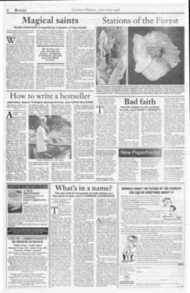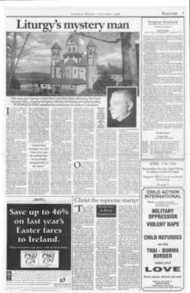Page 7, 10th April 1998
Page 7

Report an error
Noticed an error on this page?If you've noticed an error in this article please click here to report it.
Tags
Share
Related articles
The Holy Circle Christian Year Of The
True Principle Of The Liturgy
Theology Of The Liturgy
The Meaning Of Easter
Saturday's Feast :
Liturgy's mystery man
Fifty years ago, German monk Odo Casel died whilst celebrating the Easter Saturday Mass, a feast he had spent a lifetime developing and understanding. DEBORAH JONES considers his contribution to modern Catholicism
IrIS HARD to define the "sense of mystery" which, according to many Catholics, is no longer experienced in the liturgy.
One specific use of that word "mystery" was brought to light by a scholarly German Benedictine, Odo Casel, earlier this century. His definition derived from the study of Greek mystery religions which were widespread at the dawn of Christianity. He took as his starting point the Latin translation of mysteria as initia; so, in his use, "mystery" is connected with initiation, rather than meaning "somehow unknowable".
He defines "mystery" as "a sacred ritual action in which a saving deed is made present through the rite; the congregation, by performing the rite, takes part in the saving act, and thereby wins salvation."
This is the core of his work, making connections between what worshippers of ancient mystery religions believed was happening during their rites and what Christians believe is brought about through the liturgies of the sacraments.
Born in Koblenz, Johann Hermann Casel entered the Maria Laach monastery in 1905 at the age of 19, taking the name Odo. There he gained a doctorate of theology and began research into the history of liturgy and mystery-theology. He moved to Herstelle in 1922 to become convent chaplain, and stayed there until his death in 1948.
Studying the early history of the Christian Church, Dom Casel discovered the extent of the influence of Hellenistic reli
gious and philosophical ideas. These permeated the whole of the Roman Empire. Even Judaism was not immune from incorporating Hellenistic elements. Epitaphs on Jewish graves from the Roman period give evidence that Jewish ideas of the after-life ranged from pure nihilism to the rising of spiritual bodies as stars (astral bodies) and full belief in the resurrection of the body.
As well as inheriting Hellenistic ideas through Christianity's Jewish roots, early Christians, especially in Greece and Asia Minor, were exposed directly to the Greek mystery-cults and all that went with them.
The "mysteries" consisted of rites which included processions and dramatic performances, purifications and sacrificial offerings. Music and dance often accompanied them. The story of a god's birth, sufferings, death and resurrection were enacted in dramatic form and the people involved believed they would benefit in this life and beyond through their participation in the accompanying ritual.
The mystery-rite par excellence was that held near Athens in Eleusis and centred on the ancient nature myth of Demeter and Persephone. This cult spread to Rome where the goddesses were worshipped as Ceres and Proserpine.
In the spring, followers held the purification rites of the Lesser Mysteries, when those to be initiated into the cult were formally told the tale of Demeter's search through the underworld for Persephone her daughter (referred to as Kore, "the maiden") who had been abducted by Hades and, whilst in the underworld, became a "death goddess".
Through Kore's descent, sowing and reaping appeared on earth. In Dom Casel's words: "Death must be if the seed is to bear fruit... At the bottom of the... myth there is the idea that a mythical figure must die in order that life on earth may flourish and grow." The grain goddess's daughter returns to Eleusis for a limited time amid great rejoicing.
The autumn festival, the Greater Mysteries, involved the carrying of sacred objects from Eleusis to Athens, where those to be initiated were cleansed in the sea. Then followed a sacrificial rite and a great procession back to Eleusis where further secret initiation ceremonies were performed.
In the cult of Attis, called Papas (the father) by the Phrygians the vegetation god was beloved of Cybele who imposed on him a vow of chastity. This he broke and as punishment Cybele made him so mad that he mutilated himself and was changed into a fir-tree. Each year at the beginning of spring, his followers celebrated his festival over five days. On the first day a sacred fir-tree was carried through the streets accompanied by lamentations. On the second, the devotees engaged in frenzied dancing to savage music. On the third some went so far as to mutilate themselves and, on the fourth, indulged in joyful dancing to commemorate the resurrection of Antis. They rested on the fifth,
Casel presented the mystery cults as aids, useful models, for Christians in understanding their own "mystery". In his book The Mystery of Christian Worship, (1932,1959), he describes the pagan mysteries as simply "types", whereas "Christ is himself the archetype after whom all the mysteries are formed as images". For Christians, the presence of Christ in the mysteries is central, as is his redemptive work in the celebration of the liturgy.
ON THE pagan myths and the attitudes of some of the Church Fathers to them, Dom Casel comments: "The constitutive essence... of myth is a living reality, not literary invention. The worshippers believe that these events were in the beginning, and influence the fates of men today. The myth tells of a higher, abiding reality which man must come to know, in order to possess his own existence and from it form his own conduct."
Immediately following this statement he writes: "Thus the Christian must live his life in a
continuous relationship to Christ..." Dom Casel sees a theme from the ancient mysteries appearing in Hosea chapter six, which was frequently used in Eastertide liturgical readings. The text of Romans chapter six including "when we were baptised in Christ we were baptised into his death" he took as resonating with Hellenistic mystery rites of initiation. Each baptism, he argued, is a participation in the "here and now" of the dying and rising of Christ. Each liturgical celebration, especially the Mass, is such a participation.
In his preface to the 1962 English edition of Casel's The Mystery of Christian Worship, Charles Davis writes: "The liturgy is that mystery made present so that we may make contact with it, take part in it and be saved by doing so... It is of its nature the centre and source of the life of the Church and the indispensable concern of every Christian."
To relive the "mystery of Christ", Casel regarded it as necessary for people to participate actively in liturgy. This is achieved not merely by being given external roles, but by people's internal attitude, their heightened spiritual conscious ness of a deep inner sharing in the mystery.
For Casel this was no private religious experience, but essentially an action of the Church as a whole. At the time, Casel's radical thinking was met with caution to the point of hostility from the Vatican at the time. Yet the terminology he used was shortly to appear in the 1947 papal encyclical on liturgy, Mediator Dei.
It was Gagers followers who were among the most influential in the writing of the Constitution on the Liturgy (Sancrosanctum Concilium). From its introductory chapter this document asserts that Christ redeemed humanity and gave glory to God "by the paschal mystery of his blessed passion, resurrection from the dead, and glorious ascension."(par.5), continuing with the assertion that from Pentecost "the Church has never failed to come together to celebrate the Paschal mystery...".(par.6). Casel's cherished centrality of the Paschal mystery is affirmed with the Sunday celebration now taking priority over saints' days and minor feasts, "for the Church celebrates the Paschal mystery every seventh day". (par. 106)
blog comments powered by Disqus











